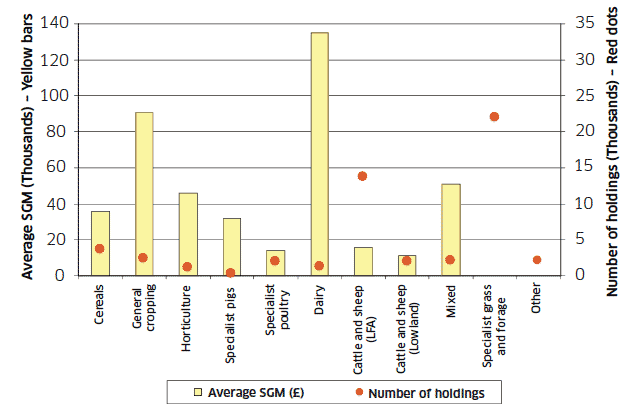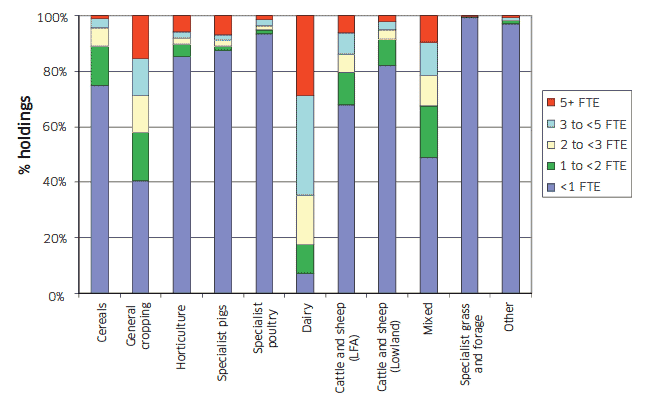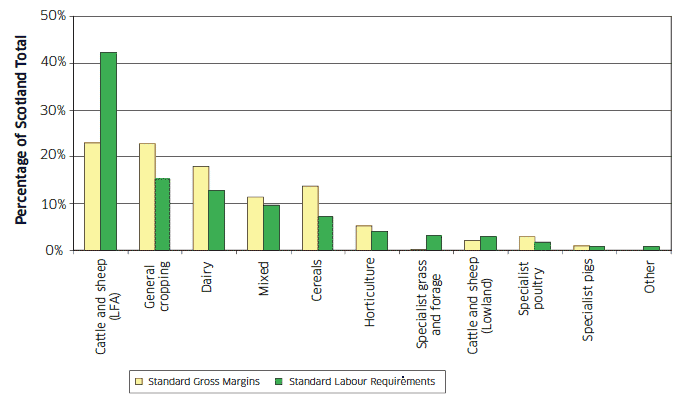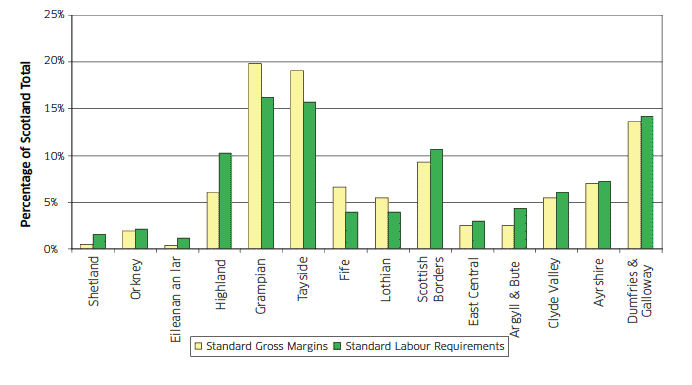Economic Report on Scottish Agriculture 2011 Edition
Invalid description field:Agriculture
This document is part of a collection
Farm size and farm type
There are a number of classifications applied to holdings in the June Agricultural Census to allow comparisons to be made between farm size and farm type. These measures are described below.
Standard Gross Margin ( SGM) represents the farmgate worth generated by a holding's crops and livestock and is calculated by applying multipliers (in £s) to all crop areas and livestock units. These multipliers are calculated at a Scotland level and take into account average output values, variable costs and subsidy levels. The multipliers used in this publication are based on a 5 year average, centred around the year 2000 and these have been applied to the 2010 crop areas and livestock units of holdings.
This SGM methodology is implemented in line with EC requirements. Please note that SGMs will be replaced in the next 12 months by a new measure called Standard Outputs, which will be based on more recent output and cost information and will also reflect changes to subsidies which were introduced in 2005.
European Size Units ( ESU) equate to the European Commission's measure. To convert from SGMs to ESU the SGM total is divided by 1,200.
Farm type is determined by the relative contribution of each holding's product mix or activity to its total SGM. If a particular activity accounts for two-thirds of the holding's total SGM then the holding is assigned to that specific farm type. There are ten farm types (cereals, general cropping, horticulture, specialist pigs, specialist poultry, dairy, LFA cattle and sheep, lowland cattle and sheep, mixed and other). To be allocated as a cereals holding, for example, cereal crops must account for two-thirds of the holding's total SGM. We have also included the 'Specialist grass and forage' farm type in our tables as these farm types relate to a large number of holdings.
Standard Labour Requirements ( SLR) represent the amount of labour required by a holding to carry out all of its agricultural activity and is also used as a measure of farm size. Standard Labour Requirements are derived at an aggregate level for each agricultural activity. The total SLR for each farm is calculated by multiplying its crop areas and livestock numbers by the appropriate SLR coefficients and then summing the results for all agricultural activity on that farm. One SLR equates to 1900 working hours per year.
The SLR coefficients used in this publication are based values in the year 2000 and have been applied to the 2010 crop areas and livestock units of holdings.
Farm types in Scotland ( Table C23)
Table C23 presents information on each of the main farm types in Scotland, showing the total number of holdings, total agricultural area and total size in terms of SGMs and SLRs. The most common farm type is "Specialist grass and forage" which totals 21,962 holdings. This is followed by Less Favoured Area ( LFA) Cattle and Sheep (13,753 holdings) and cereal holdings (3,683). General cropping, mixed, specialist poultry and lowland cattle and sheep farms are fairly prevalent (with around 2,000 holdings each) while horticulture, dairy and pig specialist holdings are the least common farm types.
The SGM total for Scotland, based on the methodology described earlier is £957 million, equating to £18,313 per holding. (For more up to date information on the value of agriculture in Scotland, please refer to the farm income statistics contained in sections A & B of this publication.) Regarding SLRs the total for Scotland is 42,140 full time equivalent workers, averaging 0.81 per holding. The SLR full time equivalent total is less than the total labour figure reported on page 114, because since the labour total (67,604 people) is a headcount (i.e. part-time is not based on full time equivalents.
SGMs and SLRs by farm type ( Table C23, C26, C28 and Charts C18- C19)
Chart C18 shows that specialist dairy holdings have the highest average SGM at £135,170. This is followed by general cropping (£90,752), mixed farming (£50,790) and horticulture (£45,765). Holdings that have the lowest average SGM are specialist grass and forage (£58), other (£44), lowland cattle and sheep holdings (£11,076) followed by specialist poultry (£13,999) and LFA cattle and sheep (£15,956). It should be noted, however, that for most farm types, these results are derived from a large number of holdings with a small amount of agricultural activity and a few very large holdings with a large amount of activity. This is illustrated in chart C18 by the red dots.
Chart C18: Average Standard Gross Margins by farm type, June 2010

Chart C19 shows the SLR distribution by farm type. It shows that just 7% of dairy holdings have an SLR of less than 1 Full Time Equivalent ( FTE) and 65% have an SLR of 3 or more. General cropping (59%) and mixed (51%) farm types are the only other two farm types with the majority of holdings above 1 SLR. Farm types with the highest proportion with less than 1 SLR are specialist grass and forage (99%), specialist poultry (93%), specialist pig (87%) and horticulture (86%). However, it should be noted that holdings with more than 1 SLR for farm types such as specialist pig, specialist poultry and horticulture account for a large proportion of output in these sectors due to their highly concentrated of production.
Chart C19: Standard Labour Requirements by farm type, June 2010

Chart C20: Distribution of Total Standard Gross Margins and Standard Labour Requirements by farm type, June 2010

Looking at the total contribution each farm type makes to total SGM in Scotland, chart C20 shows that, cattle and sheep ( LFA) and general cropping holdings account for the largest shares of SGM (23% each) followed by dairy (18%), cereals (14%) and mixed farms (11%). All other farm types each contribute less than 6% to total SGM.
Chart C20 also shows the share of national SLRs by farm type. Cattle and Sheep ( LFA) holdings account for 42% of total SLRs compared to their 23% share of SGM. This means that this farm type has a much higher labour requirement in proportion to its total SGM.
By contrast, most other farm types, including general cropping, dairy and cereals holdings have a higher share of Scotland's SGM total in comparison to their share of SLR
SGMs and SLRs by geographical area ( Table C26 and Chart C21)
Chart C21 shows that Grampian and Tayside contribute most to Scotland's total SGM, 20% and 19% respectively, followed by Dumfries and Galloway (14%). All other regional groupings each contribute less than 10% of the total This partly reflects the farm type distributions in these regional groupings as well as the size of these geographical areas.
Chart 19 also shows the geographic distribution of SLRs. Regional groupings with a lower share of SLRs compared to SGMs, such as Grampian, Tayside, Fife and Lothian, have higher proportions of farm types such as general cropping, cereal and horticulture. Regional groupings with a higher share of SLRs compared to SGM, such as Highland, Scottish Borders and Argyll & Bute have a higher proportion of Cattle and Sheep ( LFA) holdings.
Chart C21: Distribution of total Standard Gross Margins and Standard Labour Requirements by regional grouping, June 2010

There is a problem
Thanks for your feedback